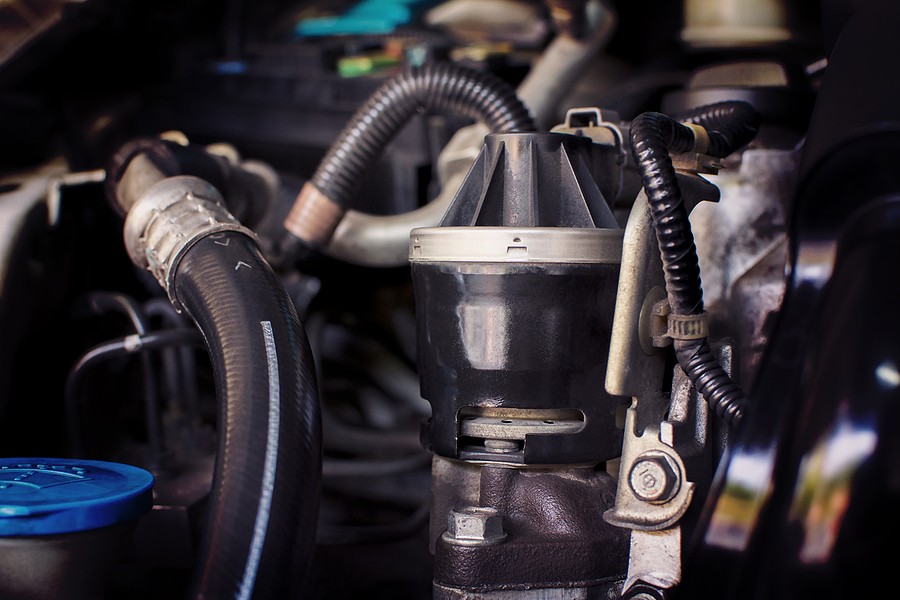The exhaust gas recirculation or EGR valve is an important component of the engine management system of your car. Its main task is to precisely recirculate metered amounts of exhaust gas to the engine intake system, which is needed to increase the performance of the engine and the fuel economy as well as help reduce NOx emissions. Over time, the EGR valve can become damaged due to carbon build up from the exhaust gasses. In order to extend its life and prevent any performance related issues to occur, you need to know when and how to clean an EGR valve.
So you ask, when and how to clean an EGR valve? Experts are recommending that you should clean your EGR valve every few years. To help you keep updated with the cleaning schedule, you can use the 50,000 mile gauge as a point of reference, or you can check your owner’s manual for any specific instructions. You can also clean your EGR valve when you experience symptoms such as hard starting, rough idle, engine vibration, engine overheating, poor acceleration, gas smell, or increased fuel consumption.
When it comes to cleaning an EGR valve, the process is pretty simple and straightforward. In fact, you can do the cleaning yourself. You will just have to follow these simple steps.
- Locate the EGR valve.
- Remove the valve and the other components that might get in the way.
- Cleaning the EGR valve by spraying an EGR valve cleaner and using a pipe cleaning brush and dull scraper.
- Soaking the valve in a cleaning solution overnight if it is hard to clean. Then cleaning its passages, surfaces, and openings with a small brush.
- Putting the EGR back to its original location.
- Checking and testing if the EGR valve works fine.
Knowing when and how to clean an EGR valve will be very helpful since it can help fix the engine performance problems of your car due to the clogging or issues with the system passages in the valve. It can also prevent severe engine damage and very costly repair bills. If you want to know more, continue reading!
When and How to Clean an EGR Valve: What are the Symptoms of a Dirty EGR Valve?
Before we discuss when and how to clean an EGR valve, we need to understand what an EGR valve is and how it works. The exhaust gas recirculation or EGR is equipped in modern internal combustion engines. It is a method used to control NOx or nitrogen oxides emissions which is a byproduct during the combustion process.
This process needs air from the environment, which is usually a combination of Oxygen and Nitrogen, and it will be combined with fuel which will ignite in the combustion chamber. When this happens, temperatures will increase that will lead to the creation of NOx emissions. This emission is known to be harmful to humans and the environment.
This is where the EGR system comes in, it functions by returning a small amount of exhaust gas to the combustion chamber of the engine through the intake manifold. This is done to lower the combustion temperatures which can help reduce the emitted NOx amount. The main component of this EGR system is the EGR valve which is usually closed.
This valve connects the exhaust manifold to the intake manifold. It is regulated by either a built-in electric step motor or a vacuum. The EGR valve’s function is basically to control the exhaust gas flow being recirculated by the system depending on the engine load. The valve will start to work when the engine has turned, has achieved its normal operating temperature, and when the speed of the car increases. The EGR valve will then control the flow of exhaust gases gradually. When the car decelerates or the engine stops, the valve will then go back to its closed position to keep the exhaust gases from flowing.
These EGR valves can become damaged over time due to wear and tear since they operate in an extreme environment. But the most common cause of EGR valve failure is carbon deposit build ups. When this happens, it can clog EGR passages or tubes which prevents the process of recirculating the exhaust gases. This problem can also cause the valve’s plunger mechanism to either stick open or close. This is why knowing when and how to clean an EGR valve is vital. You will be able to clean your valve whenever you need to, to prevent it from failing completely.
If you ask, when and how to clean an EGR valve, you can clean it when you experience the symptoms of a bad EGR valve and it includes:
- Rough Idling
Rough idling is one of the signs of a bad EGR valve. This problem can happen when your EGR valve is stuck in an open position. This is because it enables too much exhaust gas into your combustion chamber since it is constantly open, allowing continuous flow of exhaust gas into the intake manifold. This can throw off the air and fuel mixture inside it and this is what causes your engine to rough idle.
- Poor fuel economy
Since the EGR valve functions by sending the correct amount of exhaust back to the combustion chamber, it can result in a reduced temperature of the combustion chamber and improves its efficiency. However, when a faulty EGR valve is stuck in an open position, it can cause the engine to suck in air that is already measured by the mass air flow sensor and this can lead to a lean air and fuel mixture. This causes a significant drop of your car’s fuel economy.
This problem can occur since the combustion chambers’ temperature inside is lower, which leads to the fuel inside to not ignite as efficiently or as quickly as it should. You may think that a reduced fuel economy is just a minor issue, but it is not. The problem needs to be corrected immediately to prevent any further damage.
- Illuminating check engine light
Your car is equipped with a lot of sensors that monitor your engine performance, emission system, and even the performance of your EGR valve. These sensors will be able to detect problems and your car’s onboard computer will alert you by setting off your car’s warning lights. This is why an illuminating check engine light is one of the signs of a bad EGR valve.
The car’s onboard computer will let you know that something is wrong within the system by setting off your check engine light. This can happen when the sensors have detected that your EGR valve is clogged, stuck closed, or stuck open. However, a check engine light can also be triggered by some other problem. That is why it is better to have your car checked when you notice that your check engine light is on to determine what really caused it and have it repaired.
- Increased emissions
One of the signs of a bad EGR valve is increased emissions. This is because the main task of an EGR valve is to reduce emissions. So if it is bad, it will do just the opposite. If this happens, you will most likely fail your car’s emissions test. You might be able to notice that the amount of smoke in your exhaust has increased, but it is not very common.
This problem should be corrected right away since it means that an increased flow of unburned hydrocarbon gases will be emitted out of your car’s tailpipe. This can happen when your faulty valve is stuck in an open position. However, when the EGR valve is stuck in a closed position, the high temperature in the combustion chamber can enable an excessive formation of the harmful NOx gases. Either way, both are very harmful to the environment.
- Poor engine performance
Poor engine performance is one of the signs of a bad EGR valve and is probably the first sign you’ll ever notice. Remember that the EGR system helps improve the fuel economy as well as improve the engine’s performance. If the EGR valve is bad, you will be able to notice that the engine’s efficiency and performance has decreased. You may notice this problem often at lower speeds when the EGR valve is stuck in an open position and at higher speeds when the valve is stuck closed.
- Fuel smell
If your EGR valve fails to function properly, the engine will take up more fuel than usual and this can lead to more hydrocarbons being emitted from your tailpipe. When this happens, it can result in an increased amount of fuel odor and you will be able to smell it inside your car, especially if your car’s air conditioning is not in recirculation mode.
This should not be the case since the EGR valve is there in the first place to get rid or reduce the amount of NOx emissions from your tailpipe. If you notice this problem, then maybe it’s time to check your EGR valve and clean it.
- Knocking noises
One of the benefits of the EGR valve that not many people know is that it can lessen engine knocking. This is because when the combustion is kept at a lower temperature, it can keep the fuel from igniting before it should.
If you hear knocking noises from your engine, it can be caused by a faulty EGR valve stuck closed. When it is stuck closed, the temperature inside the combustion chambers will increase and when the car is at low rpm, the fuel tends to ignite early when it meets the high temperature and this is what causes the knocking sound.
When and How to Clean an EGR Valve: How Do You Clean an EGR Valve Without Removing It?
Since the EGR valve becomes dirty over time, knowing when and how to clean an EGR valve can help you maintain it and extend its life, since the carbon build ups on the valve's wall can result in premature damage. Experts are recommending that you should clean or replace your EGR valve every 50,000 miles or when you experience some issues related to it.
When it comes to cleaning your EGR valve, you can clean it using these simple steps.
- Gather the materials needed for cleaning your EGR valve such as an EGR valve cleaner, clean microfiber towel, and a pair of rubber gloves. You need to use gloves, or even goggles to protect your eyes, since the EGR valve cleaner is a corrosive product.
- The location of the EGR valve can vary from car to car so you have to locate yours. You will usually find it on the backside of the engine. If you can’t access it directly, you may have to remove some parts, but make sure to find the nearest access to it.
- Once you can access the EGR valve, remove the cover. Make sure you don’t lose any of its clamps or screws.
- Start your car and wait until it reaches its normal operating temperature. Then ask someone to sit in your car and keep its RPM in 2000. You might notice the engine’s sound change as you spray the cleaner.
- Spray the cleaner in your valve little by little so you won’t overwhelm your engine. Then wipe the EGR valve and its surrounding area using the clean towel. For stubborn build ups, you might have to remove the EGR valve to completely clean it since soaking it overnight will be needed.
- Then turn off your car and allow your engine to cool down. Once cooled down, reinstall the EGR valve cover as well as any other parts you have removed.
The EGR valve can usually last around 10 years and proper maintenance is needed for it to last this long and to prevent any performance related issues to occur. Knowing when and how to clean an EGR valve, and actually doing it helps get rid of the gunk and too much carbon build ups on your valve that have accumulated over time. Gunks need to be removed since they are preventing the EGR valve from doing its task properly and efficiently.



